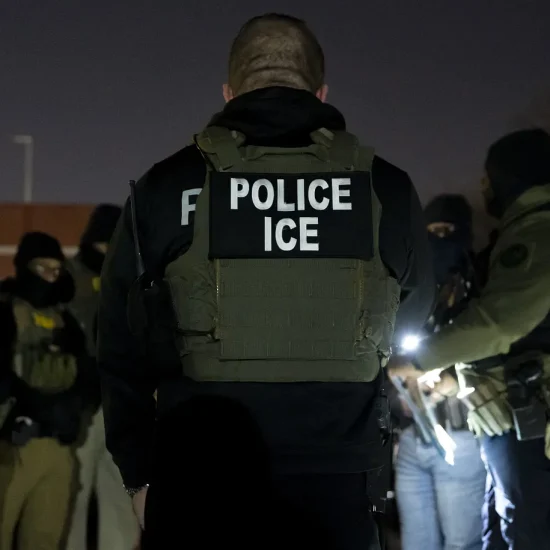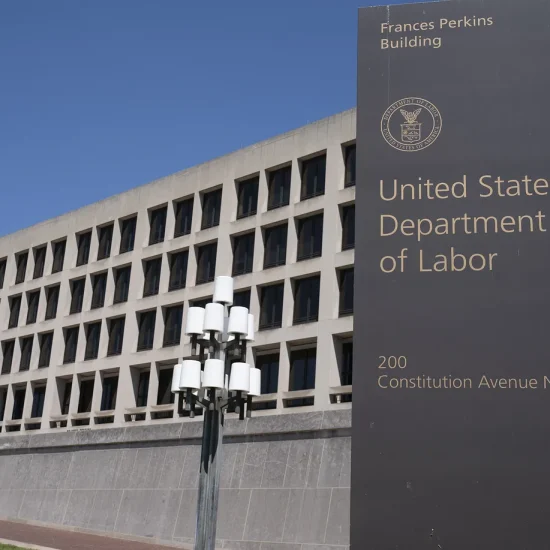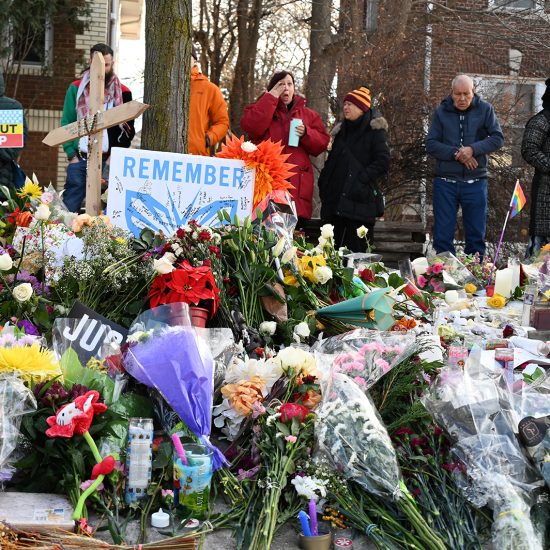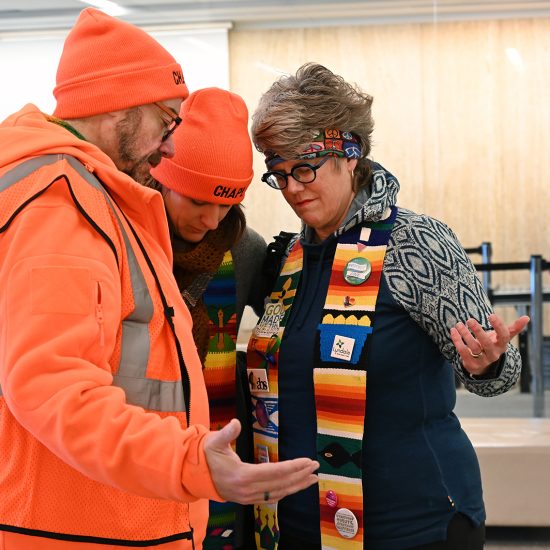

BAPTIZING AMERICA: How Mainline Protestants Helped Build Christian Nationalism. By Brian Kaylor and Beau Underwood. Foreword by Adriene Thorne. St. Louis, MO: Chalice Press, 2024. Xiii + 202 pages.
I’ve been part of mainline Protestant churches most of my life. I did spend a few years in Pentecostal churches, but I was born into the mainline Protestant church (my parents were Episcopalian, and I was baptized and confirmed in that tradition) and I’ve spent nearly forty years as a Disciples of Christ minister. During all my sixty-six years, American flags have been part of the décor of these churches, including the ones I have served as pastor. I don’t remember pledging allegiance to the American flag during church, but it was an ever-present reminder that there was a connection. As a pastor, I have joined with many other pastors praying at public events, including political ones. Of course, worship services near national holidays will feature prayers for the nation along with patriotic hymns.

Robert D. Cornwall
While Christian Nationalism has been linked to conservative evangelical churches, mainline Protestant churches have harbored such ideas as well. What is now Christian Nationalism likely was birthed by mainline Protestantism, for once upon a time the Protestant mainline might not have been legally established as a national religion, but it often has functioned in that way. As noted, I must confess my own participation in what was once known as America’s civil religion.
Most critiques of Christian Nationalism focus on conservative evangelical churches, and rightfully so since they are the most vocal participants at this moment as White evangelical churches align themselves with the Republican Party (and often embrace Trumpism). Nevertheless, history shows that mainline churches — the United Methodist Church, Christian Church (Disciples of Christ), Presbyterian Church (USA), Episcopal Church, Evangelical Lutheran Church in America, American Baptist Churches, United Church of Christ, and others — have been at the forefront of efforts to connect church and state. So, while mainliners might protest the growing problem of Christian Nationalism in the United States (and elsewhere), are we willing to acknowledge our own complicity in this growing problem?
In Baptizing America: How Mainline Protestants Helped Build Christian Nationalism, authors Brian Kaylor and Beau Underwood, one a Baptist minister and the other a Disciples of Christ minister, address an elephant in the room. The authors note that as more attention is given to Christian Nationalism, the definition of Christian Nationalism has become more complicated and even ambiguous. While the term “Christian Nationalism” might be relatively new, the reality that it describes has a long history. In many ways what is now known as Christian Nationalism has roots that go back to when the mainline Protestant churches were the dominant religious force in the country. It should be noted that the Roman Catholic school system was born in large part because public schools used the King James Version in the classroom while refusing to let Catholics use their own translations.
Kaylor and Underwood both identify with the mainline Protestant community. They are affiliated with Word&Way, a Christian media outlet that often focuses on church/state issues. Kaylor serves as President of the organization, and Underwood serves as a contributing editor. I should note that I am a regular contributor to Word&Way, offering weekly book reviews. As is true of Underwood, I am a Disciples of Christ minister (retired). Therefore, the authors and the reviewer are all being asked to consider our own complicity in the development of Christian Nationalism, which as David Gushee has demonstrated, is a threat to our democracy.
The authors begin by taking us to the first anniversary of the Jan. 6 attack on the U.S. Capitol and the commemorations of that day by mainline church leaders, such as Michael Curry, the Presiding Bishop of the Episcopal Church. While what took place on that day was much different from what happened in 2021, they show how the commemorations and remembrances shared that day in mainline circles still highlighted American exceptionalism in the form of prayer. That was the opening to Chapter 1, titled “How Firm a Foundation.” The authors present here their thesis that mainline Christians laid the foundations for what is known now as Christian Nationalism, though it was once called civil religion (with a Protestant face).
As they introduce their proposal, they also note that when the House Select Committee reflected on the events of Jan. 6, no mention was made of the role played by Christian Nationalism, despite the very overt evidence that it played a significant role (remember the Christian flags being carried by participants in the attack?) That opening chapter forms part of Section I of the book titled “Christian Nationalism in Context.” The second chapter in this section is titled “A Heretical Faith.” Here the authors focus their attention on what they call the American idol, which is nationalism. It is an idol where loyalty to the nation is foremost in the hearts and minds of the people. While that has been part of the nation’s ethos, there have been other voices that have challenged this American idol, voices that point out the heresy of nationalism.
Finally, they devote Chapter 3, which is titled “(Un)Civil Religion,” to exploring the forms of civil religion present from the beginning of the American nation, such that the founders didn’t attempt to create a Christian nation but rather drew upon religious elements that reflected the American ethos. This civil religion expressed shared national values without replacing denominational or sectarian belief systems. It used elements of Christianity, but it did so in a way that most Americans didn’t see a conflict with their more specific belief systems. They write that “Civil religion depends on downplaying differences in ways that empty religious affirmations of their meaning. In a profound way, to participate in civil religion requires the denial of one’s true faith” (p. 46). We see this in contemporary defenses of the posting of the Ten Commandments, with proponents downplaying their religious significance, suggesting only that they are part of the nation’s heritage. What is true for the Ten Commandments is true of other religious ideas and phrases such as the use of “under God” in the Pledge of Allegiance — we’re told these are simply part of our “history” and culture. Thus, to make such ideas and phrases useful they must be purposely vague.
Part II of Baptizing America is titled: “How Mainline Protestants Brought Church to State.” It moves the discussion from the overarching narrative laid out in Part I to the specific dimensions of the problem. Here is where mainliners like me might start to feel as if our toes are being stepped on, especially when it comes to Chapter 4: “Prayer Time.” The authors address prayers, most often Christian prayers, offered in public spaces, often by mainline clergy. These prayers include those offered by the chaplains of the Senate and House of Representatives. These prayers are part of the national discourse. What happens at the national level happens locally as clergy pray at public events such as city council meetings or other events.
This is where I am implicated. I serve as a chaplain for the local police department. Both in that guise and as a local clergy person, I have regularly prayed at local Memorial Day and Veteran’s Day observances, as well as at the Mayor’s State of the City Address. I offered the prayer at the installation ceremony for our member of Congress as well. While I pride myself on making my prayers as religiously inclusive as possible (our community is very diverse religiously), one could argue that I make them so vague religiously that they might be seen as denying my own faith. Hopefully, that is not true, but I will admit to finding this chapter rather uncomfortable. Perhaps you will as well, especially if you are clergy who have participated in such events.
Chapter 5, titled “One Nation . . . Indivisible,” takes a look at the inclusion of the words “under God” in the Pledge of Allegiance. The original pledge, written by a Baptist minister didn’t include those words, which were added in the 1950s, as the U.S. sought to contrast itself as a religious people against the “godless communists” of the Soviet Union. The question is whether this is a matter of taking the Lord’s name in vain! Chapter 6 then discusses the phrase “In God We Trust,” which in the 1950s became the nation’s official motto and then was placed on U.S. currency. The authors point out that the phrase has its origins in the American Civil War as part of a Union response to the Confederate claim that the Confederate States of America was, in fact, a Christian nation. While I’m complicit in the prayer chapter, I would be fine with the removal of “under God” from the pledge of allegiance and would love to see “In God We Trust” replaced as the national motto (I like e pluribus unum!).
Part III turns the tables on Christian Nationalism as outlined in Part II. This section of Baptizing America is titled “How Mainline Protestants Brought State to Church.” The first chapter in this section is titled “Seeking a Blessing” (Ch. 7). They begin by noting the churches, including St. John’s Episcopal Church, which have welcomed Presidents and hosted national events, including inaugural prayers and state funerals. The issue here is the attraction of proximity to power. I know the feeling. They write: “Mainline and progressive Christians correctly castigate evangelical or conservative leaders who render to Caesar what belongs to Jesus. Yet, they miss both the subtle and obvious ways, historically and in the present, they also participate in being priests of American culture rather than proclaimers of the Gospel” (p. 115).
Chapter 8 is titled “Worshiping America.” Here they take note of the way nationalistic elements are incorporated into worship, especially around national holidays. Consider the nationalistic hymns in our hymnals and prayers in our prayer books. Yes, they are there! Chalice Hymnal, which was published by the publisher of this book, includes “O Beautiful for Spacious Skies” and “My Country, ‘Tis of Thee.” And in Chapter 9, we come to the presence of the American flag in our churches. Yes, they are there in most mainline churches, including all that I’ve served. Sometimes they are right up front surrounding the altar or pulpit. Fortunately, in my last congregation, it was at the back of the sanctuary and largely out of sight. The authors provide us with a very helpful history of how that came to be, which is worth considering as part of our consciousness-raising on the mainline contribution to Christian Nationalism. What they reveal may surprise many.
Part IV of Baptizing America is titled “Living in the Nation Mainline Protestants Built.” The first of three chapters is titled “Failed State” (Chapter 10). Here they address the threat of Christian Nationalism to American democracy. With that in mind, they write that “The ideology of Christian Nationalism promotes a social order — legitimizing with Christian language and ideas — where the rights and flourishing of some are privileged at the expense of others.” Therefore, “the need is urgent for Christians to rally to prevent future erosion of its principles and norms in American society” (p. 165). If Chapter 10 focuses on a “Failed State,” Chapter 11 speaks to what the authors call a “Failed Church.” Christian Nationalism is not only a threat to the United States as a nation, but also a threat to the church itself.
Consider the emergence of the Church of MAGA, which has embraced Trumpism. They write that “reducing religion to political tribalism makes Christian faith appear unprincipled and hypocritical. The attractiveness of its ideas and values becomes overshadowed by its misuse and abuse for political ends” (p. 180). So, “while mainline Protestants helped lay the foundation for the larger edifice, the worst offenses now emanate from other corners, but they still sully everyone’s reputation” (p. 180). There is much truth in that statement, which means that all of us who claim to be followers of Jesus need to be self-aware enough to avoid such pitfalls.
The final chapter (Chapter 12) is titled “Moving Forward.” Here Kaylor and Underwood offer their thoughts as to how mainliners (like me) might own their complicity and move forward beyond Christian Nationalism. They respond to mainliners who speak as if we have no complicity. As they clearly demonstrate, our claims to not be complicit do not ring true. Therefore, they ask mainline Protestants, like them and me, to get our own house in order. They offer six ways that Mainline Churches can move forward. These include: 1) Learn Your Congregation’s Story; 2) Educate Your Church and Community; 3) Preach a Prophetic Word; 4) Stop Flying the Flag (before you run off and remove it, do some education first); 5) Pay attention to Language and Liturgy; 6) Urge Institutional Responses and Repentance.
They recognize (and anticipate) that what they write in Baptizing America might make some folks angry. Some of the respondents can be anticipated — those who overtly embrace Christian Nationalism — but many mainliners will not enjoy having their own complicity revealed. As noted earlier, at points I did feel somewhat uncomfortable. Their goal is not to anger people or step on toes but to raise awareness so we can effectively respond to Christian Nationalism without hypocrisy. They close the chapter by writing: “We want to see Christians get their priorities straight. We believe the future of both the Church and the nation depends on it. May God bless not a single country but all of creation. Amen” (p. 195).
As a member of the mainline Protestant community, and a member of the clergy at that, I do believe Brian Kaylor and Beau Underwood have provided the churches a gift in Baptizing America. In many ways this is a very practical book, such that it can be used in local churches to further the conversation, educating members who may not see any difference between patriotism and nationalism, especially the Christian kind. They remind us that our ultimate allegiance belongs to Christ, not to the nation such that we are connected to a much larger reality than the nation (see my book Ultimate Allegiance: The Subversive Nature of the Lord’s Prayer). So, if we are to resist Christian Nationalism then we must start by cleaning our own houses. It won’t be easy. It might be easier to remove the cross than the flag. But it is work that must be done. They have provided us with a guidebook for the way forward. For those who wish to study this in groups, a study guide has been provided at Word&Way’s Substack A Public Witness.
This review originally appeared on BobCornwall.com.
Robert D. Cornwall is an ordained minister in the Christian Church (Disciples of Christ). Now retired from his ministry at Central Woodward Christian Church (Disciples of Christ) of Troy, Michigan, he serves as Minister-at-Large in Troy. He holds a Ph.D. in Historical Theology from Fuller Theological Seminary and is the author of numerous books including his latest “Second Thoughts about the Second Coming: Understanding the End Times, Our Future, and Christian Hope” coauthored with Ronald J. Allen. His blog Ponderings on a Faith Journey can be found at www.bobcornwall.com.






